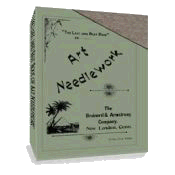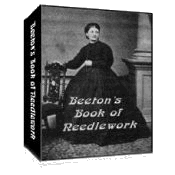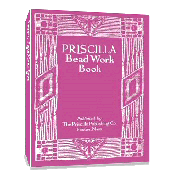Victorian Drapes
Victorian drapes, or window curtains as they were more commonly called in the 1800s, were, and still are, a very important aspect of a room’s decoration. The following information and instructions were provided to the home decorator in 1880. Today, any decorator who wants to replicate the look of a true Victorian style room will find this information most helpful.
Victorian Drapes or Window Curtains
Window curtains form a most important and necessary part of our house decoration, and the best qualities of needlework are shown to great advantage in them; the difficulties of their arrangement once overcome, there is nothing that will so enrich and beautify the room or so well repay the trouble taken for their designing and working. Their treatment involves general principles that apply also to all sorts of decorative needlework.
Before we come to the embroidery there is a great deal to be considered in the material, color, and draping of the curtains. They must look well both by daylight when they have the light behind them and are closely gathered together, and at night when they are spread out and have artificial light upon them. The material must be suitable to the uses and character of the room, neither too rich nor too homely, and it must also be chosen with special reference to embroidery. The coloring must be strictly ruled by the rest of the decoration and be in accordance with it, as well as forming a complete harmony in itself.
Curtains are generally too voluminous, so that they make a cumbrous heap by day, and by night the folds are too small and close, cutting the effect with too strong lines of shadow. For an embroidered curtain the width should not be greater than will allow the curtain to hang quite easily when drawn over the window, and the length should allow it to lie on the floor for the few inches that are needful to keep out the draught. They should be hung from poles, or brass rods, with rings, and for a small window it will often be convenient and seemly to have one curtain only, to draw over the whole window space.
Embroidery on Victorian Drapery
The embroidery should certainly be worked on the material of the curtain itself. It may seem a little cumbrous, but it is not fine stitching, and it can almost always be done in the hand, and so is not more inconvenient than a smaller piece of work in the frame, and the appearance of the curtains thus worked is so superior to those ornamented with bands of work, that the increased trouble ought not to be considered. There are some exceptions, as when work is done on dado pieces of another material, and the horizontal band is perhaps repeated higher up; but it is well to remember that the general effect of an embroidered curtain, both as a decoration and as a drapery, is better when the work is distributed over the whole surface of it than when a part only is embroidered, and when the folds in which it naturally hangs are not disturbed by the increased stiffness of an applied material. Appropriate Colors and Fabrics for Victorian DrapesThe most important qualities of curtains that form part of an art decoration — and the most beautiful curtains are but a part of the well-considered whole — are that their color should be harmonious, and that they should hang well. The color they share with the walls, the carpet, and other furniture; the hanging is their special virtue as a drapery; if we neglect either of these, especially the last, we lose the peculiar merits of the curtains as a work of art.
Suggested Fabrics for Victorian Drapes
For a dining-room, library, and for winter use in a drawing-room or where a warm and sober effect is required, the curtains will be of cloth, serge velvet, or perhaps satin. There are also some waste-silk fabrics of which the deeper colors are good, and some other special materials that are useful if chosen with due caution and regard to their durability, fastness of color, and fitness for embroidery. Rep is too stiff to hang well or to take work nicely; and none of the varieties of woolen damask are to be commended. Fabrics of mixed materials are often good in color and tempting from their handsome appearance at a small cost, but they seldom wear thoroughly well, and they are very apt to fade.Serge or diagonal cloth is an excellent material for worked curtains. It is a true and well-woven stuff, it falls in good folds, and it is soft and pleasant to work on. It will bear a rich ornament in filosel, or in applied velvet, and it is particularly ‘‘kindly” with crewel. It has a good range of tone and color, and the middle tints in it are deep without being heavy.
Velvet, or rather velveteen, is also a beautiful material for curtains. It is very durable, and it takes the work very well. Filosel is the best for the embroidery, the sheen of the silk brightening a material apt to be somber in its richness. If crewel be used on velvet, which is not much to be advised, the ground being too rich for the ornament, it should be heightened here and there with silk. Velvet does not bear applied work well; the pile interferes with the neat execution — if used, the ornament should be in velvet also, in silk or in satin —the last perhaps the best.
Instances of successful velvet curtains are, first, a deep brown velvet worked with large poppies; detached flowers alternating with a bud and leaf making a smaller sprig, not filled in, but done with a good amount of stitches so that the outline should not look bald. Simple line borders are worked at the top and bottom of the curtains, and all the work is done in one shade of bright red filosel.

Victorian Drapes
Fig. 1. — Spray for Outline. Poppies
Click on picture to see more detail.
Another beautiful set has been worked on velvet of a somewhat lighter and yellowier shade of brown than the first, with conventional sprigs applied in gold-colored silk with points and markings in two shades of gold-colored filosel, the direction of the stitches giving a great variety of tone to the leaves.
For serge and cloth curtains such repeated patterns as Fig. 2 (see below) look very well carried over the whole of the curtain, and bordered with a few simple lines near the edges. Sometimes a star or roundel, or a few transverse bars between the lines, finish the curtain well. This work may be done in crewel or in filosel, or, the main part of the work being in crewel, the centers of each pattern or star may be in filosel, which will brighten the whole effect. These patterns will look well all in one color, or two or more shades of the same color may be used; a variety of color will not suit them. A great advantage of these repeated patterns is that the curtain looks well when drawn back from the window, as what is lost in one fold is shown in another, and the beholder is not irresistibly driven to spread them out in order to solve the mystery of disjointed pieces of ornament.

Victorian Drapes
Figure 2. — Old Italian Pattern.
Click on picture to see more detail.
The branching patterns (Figs. 1 and 6 shown below) are very well adapted for curtains, and will suit any materials. These large flowers and leaves, on stems that rise from the base line of the curtain, cover the whole space with a noble damasking which modifies the tone of the ground. It goes well with a Queen Anne style of decoration, and is found in curtains of her time. A fine set was lately worked in this style on a rich cream-colored satin, which had a beautiful sheen. The ornament is in filosel, of a deep gold color. Some bordering lines are also needed for this kind of pattern.

Victorian Drapes
Fig. 1. — Spray for Outline. Poppies
Click on picture to see more detail.

Victorian Drapes
Fig. 6. — Curtain with Darned Ground. Queen Anne.
Click on picture to see more detail.
A third kind of ornament is the placing of detached sprays or single flowers at fitting distances over the curtain, called in heraldry a powdering. Great care must be taken with these sprigs or they will have a spotty effect, one of the most annoying that can be produced. To avoid it they should not contrast too sharply in color with the ground; the fact of their embroidery, even if in nearly the same color as the curtain, is sufficient to make them tell. It is in these apparently small matters that we apply art to our work and lift it above the range of the common- place and frivolous.
Another and very good style for curtains is to put on a dado of another material or color (See illustration below). The depth of this dado should be determined with regard to the walls of the room; if they have a dado, that on the curtains should be nearly of the same height; if the walls have a division high up, with a frieze above the patterned paper, the curtains will probably look better in another style. For a large and lofty room the broad band of a darker color on the curtains looks very well; it should be of a darker shade of the same color as the curtain, or at least harmonize with it, as a warm brown with a deep red will often do.

Victorian Drapes
Curtain with Dado.
Click on picture to see more detail.
For the ornament, a row of upright stems of large flowers boldly embroidered or in applied work is very handsome, and this may be worked on the dado before it is sewn on the curtain. The body of the curtain may be plain or may be worked with single flowers of the same kind or corresponding in color to those below, always remembering the caution given above with regard to sprigs. If the dado be ornamented and the rest of the curtain left plain, it may be improved by a band of the same stuff as the dado and (about a fourth of its width) embroidered to correspond with it, and placed about its own width from the top of the curtain. The whole may be further enriched by narrow borders of stitches where the bands are sewn on to the curtain, or with woven braids or laces, as the upholsterers call them. The colors of these should be carefully chosen; perhaps the middle tints of the embroidery will give the best shades.
The curtains in one of the state rooms of the new Town Hall at Manchester, which were designed by the Princess Louise, have a broad dado of dark velvet upon deep red cloth. On this dado is a bold pattern of sunflowers and their leaves standing up all in a row; they are in applied work, with several threads of crewel sewn down round each leaf and flower. A band of dark blue cloth goes round dado and curtain, edged with narrow lines of brown, and studded with circles of yellow- brown cloth also edged with brown — the three primary colors being brought into harmony boldly and successfully.
It is plain that such curtains would only suit a spacious hall, but if this style be chosen for a room in which there is some fear of its proving too conspicuous and unduly occupying the eye, it will be better to have very little contrast in tone between the ground of the curtains, the dado, and the ornament; this will give a very soft and pleasant effect. It may be made still more retiring by dispensing with the upper applied band, and working a branching pattern over dado and ground alike. For instance, two shades of golden brown serge or cloth, or cloth and a velvet dado, worked with filosel of rather deep gold color, telling somewhat sharply on the dado and more softly on the cloth, will be rich and harmonious.
Perpendicular arrangements of ornament are not much advised for curtains. They seldom have a pleasing effect, for they carry the eye mounting up to an uncomfortable height where there is nothing further to gratify it. If a room be so low that some upright lines are desired for it, the stems of such patterns as Fig. 1 will probably be sufficient to give the wished-for effect.
Other Samples of Victorian Drapes

Victorian Drapes
Fig. 3. — Spray of Poppies
Click on picture to see more detail.

Victorian Drapes
Fig. 4. — Curtain in Applied Work.
Click on picture to see more detail.
If you don't have time or feel making your own Victorian draperies are beyond your skill set, you can always purchase some that will fit your needs. Take a look below:
For more information on Victorian Drapes, see:
Drapery, Page 1 Page 3 Victorian Portieres
Return to top of Victorian Drapes page.
Return to Victorian Home Decor page.
Return from Victorian Draperies page to Home.



 433 pages!
433 pages!

